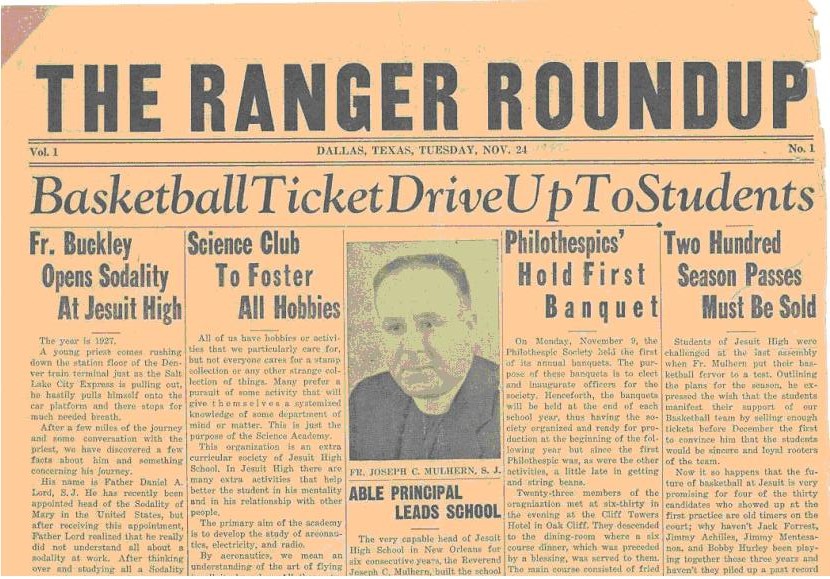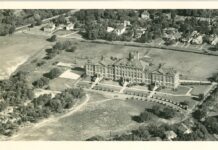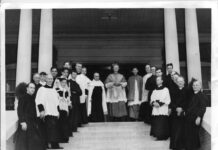The October 8, 1966, The Texas Catholic editorializes that
“the first edition of The Roundup issued Nov. 24, 1942, can hardly be called ‘memorable.’ Devoted mainly to gossip and descriptions of various newly formed organizations, the whole affair would be considered a monstrous failure if published today by the present staff. But for the first attempt it was extremely well done and it represented a determination to always give Jesuit High School the best paper possible. In this pursuit of the best, The Roundup has passed through many stages of development. . . .
When the paper began in 1942, it appeared in the form of a four-page publication, issued monthly, which collected its many diverse stories under the banner The Ranger Roundup. The name was reduced to its present form, The Roundup, in 1944, when the paper became a quarterly magazine. Four years later the paper resumed monthly publications, but retained its new title.
The most important change came in 1956, when a yearbook staff was formed, separate from the regular staff of The Roundup. Since that year, this staff has produced a yearly volume, The Last Roundup, which serves as a permanent record of students’ years at Jesuit.
The most recent changes came in the first edition this year. Under the direction of its moderators, Mr. Mike Roach and Mr. John Stack, S. J., and its editors-in-chief, Jeff FitzGerald and Biff Godfrey many innovations have been effected.
First of all the staff, which in years past had been made up of a select dozen or so, was increased to 67 members, forming three staffs, thus allowing more talented people into The Roundup than ever before. Second came the increased circulation of the paper, which jumped from 800 to 4,000 copies since last year.
The Roundup has grown from a four-page edition in 1966, and from a 17-man staff to a large and complex organization, with members in every other branch of the school’s activities.”
1940s
The May 1944 Roundup included a spoof of the financial report of 1943 – 1944. Among the many spurious items were the salaries of the editors at $1,540.46; salaries to Detectives for watching Detectives who watch the Moderator at $2, 053.33; Money stolen by moderator at $2, 530.53.

In the first edition of November 1945, the publication gave tribute to their new principal, Fr. Ross Druhan, S. J., especially to his ability to address and solve problems, his concern for human understanding, and his determination to better the school.
The May 1946 edition announced: “In consideration of the fact that the graduating class of 1946 will be the first ever to compete [sic] a full high school course within the walls of Jesuit, we feel that it is both fitting and appropriate to publish this issue of the Roundup as tribute to their memory. TO THE FOUR-YEARS OF JESUIT HIGH SCHOOL, [then,] THIS BOOK IS RESPECTFULLY DEDICATED.
In its first years The Roundup published numerous literary pieces. The Spring 1947 edition reported: “As you know, it’s the policy of the Roundup to print twenty pages of literary per issue. However, this month, out of the twenty-one stories that were turned in only . . . six were judged as meeting the standards of publication.”
In 1947 -1948 the administration was questioning what the school paper should look like, a quarterly or a monthly? A newspaper or a magazine? The Minister’s Diary notes that the quarterly the year before lost about $230.00. “The opinion was advanced that a monthly news format type would be a more ‘up to the minute’ publication, would tend to foster School spirit and arouse more interest among students, and be a more practical means of keeping the school’s interests, programs, & problems before the Student Body. Most of the Consultors seemed to favor the monthly provided it could be published on schedule, and did not cost too much as compared to the quarterly.” In the end a quarterly was deemed best.

The highlight of the 1947-1948 year was the first “yearbook” called The Last Roundup. The soft cover book noted the seniors in individual pictures. Group class pictures were included for the underclassmen. Previously, The Roundup covered graduation as part of its regular newspaper format.
In 1948 – 1949 the paper made its debut as a monthly newspaper (from a quarterly magazine) because the students “clamored for” it according to the staff of the September 1948 issue. The writer makes a plea to the student body to support the paper by buying it and selling it to others. The subscription price was $1.00 per year. In addition, the staff asks the students to give The Roundup “not only your complaints, but your constructive criticisms, your ideas for improvement.” The paper was printed on slick paper until 1956 -1957 when it went to newsprint.

The staff is introduced in this issue: Mark Tolle, editor; Johnny Stacer, assistant editor; Tommy Cullinan, feature editor; Pat Shea and Neil O’Brien, sports editors; Lupe Quevedo , staff artist; Edo Biasatti, business manager; and Lelong Beckham, assistant business manager. Edward P. Curry, S. J. served as faculty advisor.
The March 1949 issue describes The Last Roundup as an annual in book form which will feature the seniors. It also will “be a complete roundup of all Jesuit High activities of the current scholastic year, and will give full play to all organizations and classes in the school. These will be covered not only in writing but also by copious illustrations.” The book sold for $1.00 through a subscription drive that opened for ten days in April.
In 1949 Mark Tolle won a Rotarian award for best letter to the Rotarians and The Roundup had overwhelming success with its new newspaper format. Mr. Jimmy Scanlan, superintendent of the Padgettt Printing Company, and Mr. Ed Whetzle, advertising manager of Drilling Magazine helped the newspaper staff learn “the correct way to set up a newspaper.” In addition, Fr. Edward P. Curry helped the staff learn about deadlines.
On May 5, 1949, The Roundup held its banquet at the Italian Village to award honors and announce the next year’s editor and other positions.
Sources: The Principal’s and Minister’s Diaries, The Province Prefect Annual Report 1953, The Mothers’s Club Scrapbooks, and the student school newspaper, The Roundup)




